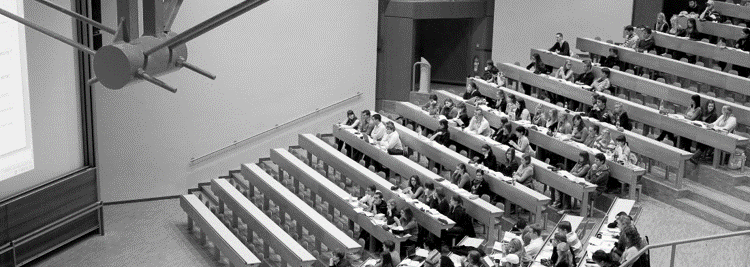Here you find questions and answers about the topic
1. What are hybrid courses?
Hybrid courses are a special type of "blended learning" or "flipped classroom", and refer to different teaching/learning scenarios that combine online and face-to-face interaction or physical presence in varying proportions. Blended learning combines the advantages of face-to-face interaction and e-learning in such a way, that the respective advantages get emphasised and disadvantages are compensated.
The current understanding of "hybrid" has been given a special component and today also refers to teaching/learning a scenario in which a course is offered both, in person and online at the same time. These scenarios also combine face-to-face (physical presence) and online components.
2. When is a hybrid seminar course recommended?
- As hybrid teaching does not offer any additional pedagogic or didactic value compared to a blended learning scenario, we recommend using it with caution.
- Hybrid teaching is appropriate when on-site teaching is necessary for the development of students' skills, but not all students can or may be on site.
- Hybrid formats are suitable for all phases of a course. Tasks for online participants may need adjustment in order to create compareable activities within a video conference during work phases.
3. What are the minimum technical and personnel requirements?
- Course room with network connection (e.g. via eduroam) and projector.
- Students on site and online.
- At least one on-site assistant (e.g. a student assistant or alternating course participants each session) who represents the online participants and, e.g. presents questions from the chat or forwards them to you - this makes it easier for you to concentrate on the contents of your course.
- Laptop with a webcam and microphone (better: headset or wireless microphone connected to the laptop) for the instructor, if necessary external speakers or connection to the room's audio system. With the borrowable MediaBoxes, KIM.LR offers a high-quality set of external recording devices: https://streaming.uni-konstanz.de/en/kimmediabox/
- Laptop for the on-site-assistant.
- Web conferencing platform (e.g. BBB, WebEx, Zoom). If you use these services in a web browser, please use the latest version of Chrome or Firefox.
- If your course is to be offered as live stream a lecture room equipped with Opencast camera technology is recommended. Further information on the recording and streaming functions of Opencast and on the utilisation of lecture rooms equipped with pre-installed camera technology can be found here: https://streaming.uni-konstanz.de/opencast/
4. How do I organise a hybrid course with my own laptop?
- You connect your laptop to the network (e.g. via WLAN via eduroam) and the projector in the room. If necessary, open your presentation (e.g. PowerPoint) and switch the screen output to the projector.
- Open a virtual conference room on a web conferencing platform: activate your webcam and microphone, deactivate the speakers.
- The camera and microphone of online participants should be set off in advance (corresponding settings can be made before and during the course in the web conference room settings).
- Use the "Share screen" function to make your presentation visible to online participants and start your course.
- Your on-site assistant joins the web conference with a laptop and communicates questions from the chat. Your answers are instantly audible to all participants; if no other microphones are used in the room, questions from the audience must be paraphrased on site for online participants.
- You can use your laptop to present contributions from online participants directly. It shows the web conference, the webcam image and presentations of the online speakers via the projector. The sound on site is played via the connected speakers. To avoid howling noises, microphones in the room should be muted. Dialogues with online participants while the speakers are on, generally are problematic due to the risk of howling noises- microphones should be activated/deactivated as soon as possible, and the speakers volume adjusted on site if necessary.
5. What do I have to consider legally and where can I find information on data protection regulations?
You can find all legal aspects that you need to consider for teaching online with video conference software on the website of the Legal Affairs Office:
Data protection for online teching and courses
When using web conferencing software, you must provide participants with the data protection information on the platform used. The data protection information for every web conferencing system authorised by the university can be found on the following page:
https://www.kim.uni-konstanz.de/en/services/research-and-teaching/videoconferencing/

